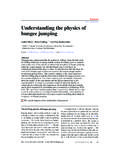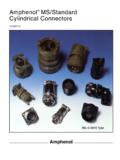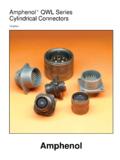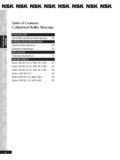Transcription of Pin-hole water flow from cylindrical bottles
1 TEACHING PHYSICSPin- hole water flow fromcylindrical bottlesPaulo Murilo Castro de Oliveira, Antonio Delfino, Eden VieiraCosta and Carlos Alberto Faria LeiteInstituto de F sica, Universidade Federal Fluminense, av. Litor anea s/n,Boa Viagem, Niter oi RJ, Brazil 24210-340We performed an experiment onelementary hydrodynamics. The basicsystem is a cylindrical bottle from whichwater flows through a Pin-hole located atthe bottom of its lateral surface. Wemeasured the speed of the water leavingthe Pin-hole , as a function of both thetime and the current level of water stillinside the bottle. The experimental resultsare compared with the theory. Thetheoretical treatment is a very simple onebased on mass and energy conservation,corresponding to a widespread exerciseusually adopted in university basicdisciplines of extended the previous experimentto another similar system using twoidentical bottles with equivalent water flowing from the first bottlefeeds the second one located below same concepts of mass and energyconservation now lead to a non-trivialdifferential equation for the lowest bottledynamics.
2 We solved this equation bothnumerically and analytically, comparingthe results with the experimental university textbooks (see for example [1 7])refer to the problem of water squirting freely froma small hole in a bottle, as in figure 1. The waterspeedVat the hole depends on the heightHof thefree liquid surface above the Pin-hole , accordingto Torricelli s the acceleration due to the forceof the Earth s gravity. This result was obtained byGalileo s assistant E Torricelli in 1636 [7]. It isnormally obtained nowadays through Bernoulli stheorempC12 V2C by Daniel Bernoulli in his book onhydrodynamics of 1738, which appeared a century110 Phys. (2) March 2000 TEACHING PHYSICSF igure apparatus used in our testof Torricelli s law.
3 Successive values of the heightHwere read off from a scale previously glued onto the bottle surface, with points cm apart fromeach other. The corresponding speed of the waterflowing at the Pin-hole was indirectly measuredusing the distanceXread off the horizontal timesTwere also measured duringthe Torricelli s law. Here, represents the liquiddensity, whilep,Vandyare the local hydrostaticpressure, speed and height, respectively, allmeasured at the same point inside the liquid. TheconstantCmeans that the sum on the left-handside stays the same, independent of the particularpoint where the measurements are performed. Inour case, one must take two points: the first at thefree liquid surface inside the bottle, withyDH,neglecting the speed there; and the second pointjust after the Pin-hole , withyD0, outside thebottle.
4 The hydrostatic pressure at these two pointsis the same, namely the atmospheric (1) follows directly. This theorem holdsfor stationary liquid flows, and comes from energyconservation arguments. Thus, in adopting it oneis neglecting any energy loss due to viscosity,turbulence, the downward speed of the free liquidsurface inside the bottle is neglected, there is amissing factor a2=A2/on the left-handside of equation (1), whereAandarepresent thecross sections of the bottle and the liquid vein(outflow diameter of the Pin-hole ), correction comes from equation (7) to beintroduced later on. The cylindrical bottle usedin our experiment has a diameter of cm,and the Pin-hole is made of a thin plastic tube(extracted from a ballpoint pen) whose diameter mm.
5 Thus, the neglected factor a2=A2/represents a relative deviation of the order of 10 7,much smaller than our experimental , the liquid vein cross sectionais a littlebit smaller than that of the Pin-hole , due to thephenomenon ofvena contracta[3, 5, 7].The text is organized as follows. In the nextsection we describe our first, simplest experimentwith a single bottle (figure 1), where we measuredsimultaneously the speedVand the timeTelapsedfrom the initial heightH0, while the bottle drainsoff, for successive values of decreasing speeds are indirectly obtained fromthe distanceXmeasured on the horizontal rulelocated at a fixed height below the bottle:Xis thus proportional toV.
6 In order to compareour experimental results with the theory, a simplecorrection is made to Torricelli s law, takingenergy losses into account. We also obtain thesolution of Bernoulli s differential equation (2) forthis case, giving the time evolution the flow, comparing them with theexperiment. In the subsequent section we describeour second experiment with two identical bottles (figure 2), where the water flowing from the firstbottle is caught by the second through a , the bottles are equally filled, and thenboth flows start at the same time. Since we hadalready verified the validity of Torricelli s relationwith good accuracy from the first experiment,we used the value determined in this way inthe second experiment, instead of measuring thebottom velocityV0.
7 Our accuracy in measuringH(orH0) is better than the corresponding accuracyforX(orX0orV0).Thus, in this secondexperiment we measured only the time In this case, the analytical solutionfor Bernoulli s differential equation is not trivial,and we solved it numerically. Nevertheless, theanalytical solution could be obtained by usingsome tricks. The results are compared with theexperiment. Finally we present our (2) March 2000111 TEACHING PHYSICSF igure experiment, where the waterflowing from the first bottle is caught by thesecond through a funnel. Successive heightsH0were measured as a function of the one-bottle experimentThe water flows through a horizontal thin plastictube installed at the Pin-hole .
8 A (parallel) rule isplaced below the Pin-hole at a distanceY0. Thus,the fall time of a small segment of water isp2Y0=g. This is the constant of proportionalitybetween the measured distanceXin figure 1 andthe speedV, :The water flow is started by one of the authors,responsible for measuring the heights, from aninitial valueH0D20:0 cm, at timeTD0. At thissame instant, another author starts a chronometerwith a memory (actually, a computer programwhich stores the time elapsed sinceTD0 eachtime some key is hit), and a third author reads thevalue ofXoff the rule. A fourth author recordsthis value. The whole procedure is repeated atintervals ofHD0:5 cm.
9 At the end, one hasa three-column table withH,TandX(this last05101520H (cm)0200400600800X2(cm2)R = cm (linear fit)R^Figure rangeX2versus heightHforthe one-bottle experiment shown in figure 1. Ourestimated error bars are represented by the sizeof the symbols. The straight line is the best linearfit for the experimental data. The inner diameter ofthe bottle is cm, and that of the Pin-hole tubeis mm. The initial height isH0=20:0 cm,according to which we measured the initialhorizontal rangeX0=28:0 0:3 proportional to the speedV). The initialrangeX0D28:0 0:3 cm was measured forY0'11 cm (for the sake of clarity, figure 1 showsa larger separation, but our actual measurementswere all taken withY0'11 cm), correpondingto an initial speedV0'1:9ms 1, supposingg'9:8ms 2.
10 However, one does not need toperform the transformation fromXtoV: we willalways useXinstead ofV. In doing so, we donot have to worry about precise measurements 3 shows the plot of the squared rangeX2versus the heightH, which must be a straightline, namelyX2D4Y0H, according to Torricelli slaw, equation (1).However, our experimentalstraight line does not cross the origin!Onthe contrary, the best linear fit for our data,the continuous R/withoptimum values forKandR, crosses theHaxis at a minimum residual heightRD2:05 , during the experiment, we noted that thecontinuous water flow ceasesbeforethe surfacelevel inside the bottle reaches the Pin-hole .








